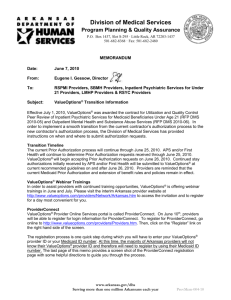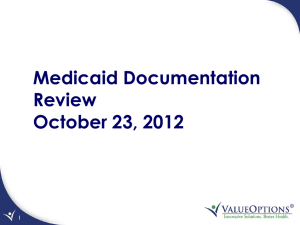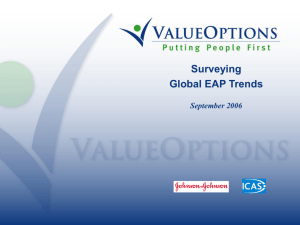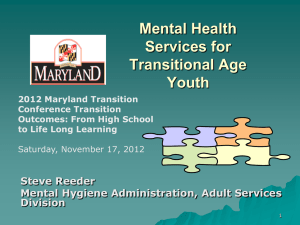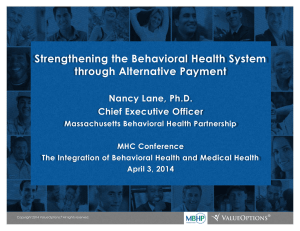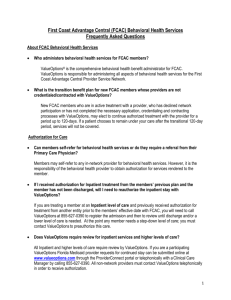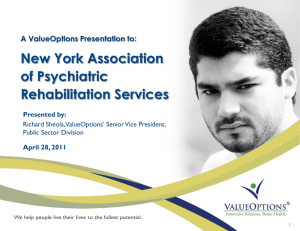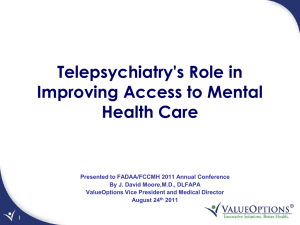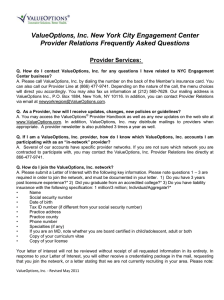Engaging the Multigenerational Workforce Slides
advertisement
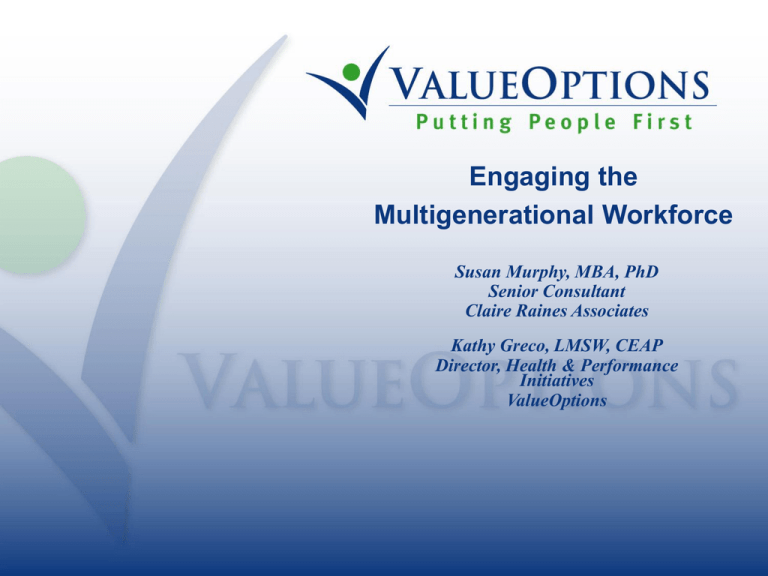
Engaging the Multigenerational Workforce Susan Murphy, MBA, PhD Senior Consultant Claire Raines Associates Kathy Greco, LMSW, CEAP Director, Health & Performance Initiatives ValueOptions Agenda The Business Case Overview of the Generations Workplace Implications Best Practices Generational Perspectives on the EAP and Typical Issues Discussion 2 SummitQuestions@valueoptions.com The Business Case Competition for talent More generations working side by side Productivity and business results linked to work environment Customers from all generations 3 SummitQuestions@valueoptions.com Primary Aspects of Diversity Generation Gender Sexual Orientation Race Ethnicity Physical Qualities Country of Origin Adapted from Workforce America! by Marilyn Loden & Judy Rosener 4 SummitQuestions@valueoptions.com Generations • 2007 & 2011 WWII Generation (Traditional Generation) born before 1940 in 2011 67 plus 71 plus 3% 1% 5 million 2 million Baby Boom Generation (Post WWII Boom in Births: 1946-1964) born 1940-1960 in 2011 47-67 51-71 37% 29% 55 million 46 million 27-47 31-51 45% 44% 68 million 69 million 15% 26% 22 million 40 million Generation X born 1960-1980 in 2011 Millennial Generation (Generation Y) born 1980-2000 in 2011 5 7-27 11-31 SummitQuestions@valueoptions.com Questions for Organizations What is the generational composition of your current workforce? What will the generational composition of your workforce be in 5 years? What is the generational composition of your customer base? What will the generational composition of your customer base be in 5 years? 6 SummitQuestions@valueoptions.com Our Perspective and Values …are shaped by the world around us during our formative years. 7 SummitQuestions@valueoptions.com WWII Generation 8 SummitQuestions@valueoptions.com WWII Generation 9 SummitQuestions@valueoptions.com WWII Generation 10 SummitQuestions@valueoptions.com Baby Boom Generation 11 SummitQuestions@valueoptions.com Baby Boom Generation 12 SummitQuestions@valueoptions.com Baby Boom Generation 13 SummitQuestions@valueoptions.com Generation X 14 SummitQuestions@valueoptions.com Generation X 15 SummitQuestions@valueoptions.com Generation X 16 SummitQuestions@valueoptions.com Millennial Generation 17 SummitQuestions@valueoptions.com Millennial Generation 18 SummitQuestions@valueoptions.com Millennial Generation 19 SummitQuestions@valueoptions.com How Parenting Differed 20 WWII Baby Boomer Discipline Schedules Conformity Strict obedience “Spare the rod, spoil the child” Dr. Spock Throw away schedule Love & nurture, pamper & cherish Stay-at-home moms Generation X Millenial Parenting by proxy Working moms Latchkey children Soaring divorce rates Autonomy & independence Parental advocacy Put children first Soccer moms Supervision Strictness on drugs, drinking, driving SummitQuestions@valueoptions.com Benefits of the Multigenerational Team Can attract/retain talented people of all ages, more inclusive More flexible Can gain/maintain greater market share because reflect multigenerational market Decisions are stronger, more broad-based with multiple perspectives More innovative and creative Can meet needs of diverse public and can relate more effectively 21 SummitQuestions@valueoptions.com Root Causes of Conflict Work ethic Technology Relationships Outlook 22 SummitQuestions@valueoptions.com Root Causes of Conflict (cont.) Perspective View of authority Leadership 23 SummitQuestions@valueoptions.com The Titanium Rule Do unto others, keeping their preferences in mind. 24 SummitQuestions@valueoptions.com Communication WWII Generation • Logical, linear, conservative Baby Boom Generation • Personable, information = reward Generation X • Direct, straightforward, results-oriented Millennial Generation • Positive, motivational, personal goal-oriented 25 SummitQuestions@valueoptions.com Turn-offs WWII Generation • Profanity, slang, poor grammar, disrespect Baby Boom Generation • Brusqueness, one-upmanship Generation X • Using time poorly, corporate-speak Millennial Generation • Cynicism, sarcasm, condescension 26 SummitQuestions@valueoptions.com Motivation for WWII Generation WORDS that motivate: • “Your experience is respected here.” REWARDS that motivate: • Tangible symbols of loyalty, commitment and service MANAGEMENT ACTIONS that motivate: • Managers connect their actions to overall good of organization 27 SummitQuestions@valueoptions.com Motivation for Baby Boomers WORDS that motivate: • “We need you. You can make a difference.” REWARDS that motivate: • Personal appreciation, promotion, recognition, status symbols MANAGEMENT ACTIONS that motivate: • Managers get them involved and show them how to make a difference 28 SummitQuestions@valueoptions.com Motivation for Generation X WORDS that motivate: • “Do it your way.” “There is life beyond work.” REWARDS that motivate: • Free time, upgraded resources, opportunities for development, bottom-line results, certifications to add to resume MANAGEMENT ACTIONS that motivate: • Managers give them choices and let them work autonomously 29 SummitQuestions@valueoptions.com Motivation for Millennials WORDS that motivate: • “We respect you here.” “What are your goals?” REWARDS that motivate: • Awards, certificates, tangible evidence of credibility MANAGEMENT ACTIONS that motivate: • Managers connect actions to their personal and career goals 30 SummitQuestions@valueoptions.com Is Your Workplace Gen-Friendly? _ There’s not just one type of successful person here. _ On teams, we include a variety of perspectives. _ We treat employees as customers. _ We sometimes joke about our different perspectives. _ We talk openly about what we want from our jobs. _ We base policies on what customers/employees want. 31 SummitQuestions@valueoptions.com Gen-Friendly (cont.) _ We have a minimum of bureaucracy and red tape. _ People who work here have the big picture along with specific goals and measures—and feel free to find their own best way of reaching them. _ We expect the best from everyone. _ We focus on retention every day. 32 SummitQuestions@valueoptions.com 12 Best Practices Companies that are most successful at recruiting and retaining across generations… 1. Study generational composition; use the information in many HR strategies. 2. Train about generations in a variety of formats. 3. Match workforce to customer base. 4. Include all generations on boards and councils. 33 SummitQuestions@valueoptions.com 12 Best Practices (cont.) Companies that are most successful at recruiting and retaining across generations… 5. Support continuing education. 6. Reward managers for retention. 7. Reward performance and productivity. 8. Offer horizontal movement. 34 SummitQuestions@valueoptions.com 12 Best Practices (cont.) Companies that are most successful at recruiting and retaining across generations… 9. Plan for succession. 10. Offer mentoring programs. 11. Offer flexible scheduling. 12. Offer a wide variety of benefits. 35 SummitQuestions@valueoptions.com Questions? 36 SummitQuestions@valueoptions.com 37 SummitQuestions@valueoptions.com Analysis Developed profile in terms of: • demographic characteristics • lifestyle characteristics • communication preferences Identified patterns of substance abuse and related problems Projected needs/behaviors in light of historic EAP and behavioral health care utilization patterns 38 SummitQuestions@valueoptions.com Engage Developed CD using multigenerational approach Highlighted the unique issues and needs concerning each generational group, including pertinent workplace issues: • mental health issues • alcohol and substance abuse • financial • family (child care, elder care, etc.) Provided information and tools to help employers address these issues: • articles • posters/brochures • sample timelines 39 SummitQuestions@valueoptions.com The Gen Y Perspective of the EAP Predisposed to seek treatment only in crisis Seek the services of the EAP less often than the general employee population Of the Gen Y workers seeking assistance from the EAP, more tend to be female Male employees more likely to receive services related to substance abuse 40 SummitQuestions@valueoptions.com Typical EAP Problems Gen Y Members Experience • • • Mental health issues • • • Traffic violations Drunk driving Criminal issues (such as assault) Child custody and support Pregnancy Routine, preventive medical care Accidents Depression Anxiety Appearance of long-term, chronic disorders, such as bipolar disorder and thought disorders (e.g., schizophrenia) Marital/family issues • • • • • 41 Medical issues • • • Debt management Savings Loans and credit Legal issues • • • • Financial issues Communication Financial dependence Effective communication Healthy relationships Cohabitation Substance abuse issues • • Binge drinking Experimentation with illicit drugs SummitQuestions@valueoptions.com The Gen X Perspective of the EAP EAPs help employees balance work and life. Gen X employees look to what the EAP can do for them. Skill development and wellness seminars, work/life programs and workplace programs designed for flexibility will draw the attention of Gen X employees. 42 SummitQuestions@valueoptions.com Typical EAP Problems Gen X Members Experience Financial issues • One-income families with children • Savings Medical issues • Pregnancy • Smoking-related health issues Legal issues • Divorce • Child custody and support Mental health issues • Depression • Anxiety • Eating disorders Marital/family issues • Career vs. marriage and family • Parenting roles • Relationships Substance abuse issues • Marijuana • Alcohol 43 SummitQuestions@valueoptions.com The Baby Boomer Perspective of the EAP Have driven the development of EAP services over the last 20 years Broad-brush programs providing assistance with work stress, family issues, assessment for depression and anxiety, as well as grief and loss issues Legal, financial and work/life services have been incorporated into many EAP services with the aim of assisting employees on a variety of agingrelated topics 44 SummitQuestions@valueoptions.com Typical EAP Problems Baby Boom Members Experience Financial issues Medical issues • Lifestyle issues • Chronic illness Mental health issues • Depression • Anxiety • Self-esteem Substance abuse issues • Disease • Prescription drug issues • Savings and debt management • Retirement planning Legal issues • Estate planning, wills and trusts • Long-term care • Issues of aging relatives Marital/family issues • • 45 Child and elder care Marital/family relationships SummitQuestions@valueoptions.com The Traditional Generation Perspective of the EAP Occupational alcoholism program May not be aware of or be comfortable pursuing the broad spectrum of employee assistance services now available Less likely to seek the services of the EAP Likely to feel obliged to handle any personal concerns alone 46 SummitQuestions@valueoptions.com Typical EAP Problems Traditional Generation Members Experience Financial issues • Retirement • Long-term care • Managing income and expenses Medical issues • Chronic disease • Diseases of aging Legal issues • Estate planning, wills and trusts • Health care proxy and living wills Mental health issues • Depression Marital/family issues • Marital/family relationships 47 Substance abuse issues • Disease SummitQuestions@valueoptions.com Approach Target interventions to specific human capital risks Manage risks using resources efficiently Offer employers solutions to engage the workforce Build an environment that fosters employee resiliency 48 SummitQuestions@valueoptions.com Expected Outcomes Increased knowledge of needs and preferences of generational populations Increased awareness of EAP services among targeted population Increased EAP utilization among targeted population: • Self-referred • Management referred Reduced prevalence of alcohol misuse and abuse among targeted population 49 SummitQuestions@valueoptions.com Discussion 50 SummitQuestions@valueoptions.com Resources Susan Murphy http://www.generationsatwork.com/ drsmurphy@consult4business.com Engaging the Multigenerational Workforce www.valueoptions.com/spotlight_YIW/index. htm 51 SummitQuestions@valueoptions.com
